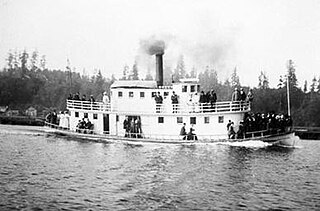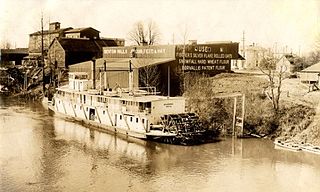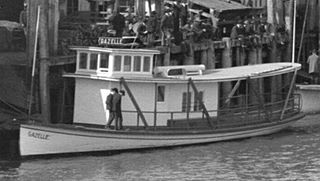
The history of steamboats on the Oregon Coast begins in the late 19th century. Before the development of modern road and rail networks, transportation on the coast of Oregon was largely water-borne. This article focuses on inland steamboats and similar craft operating in, from south to north on the coast: Rogue River, Coquille River, Coos Bay, Umpqua River, Siuslaw Bay, Yaquina Bay, Siletz River, and Tillamook Bay. The boats were all very small, nothing like the big sternwheelers and propeller boats that ran on the Columbia River or Puget Sound. There were many of them, however, and they came to be known as the "mosquito fleet."

The Coquille River starts in the Siskiyou National Forest and flows hundreds of miles through the Coquille Valley on its way to the Pacific Ocean. Bandon, Oregon, sits at the mouth of the Coquille River on the Pacific Ocean. Before the era of railroads and later, automobiles, the steamboats on the Coquille River were the major mode of transportation from Bandon to Coquille and Myrtle Point in southern Coos County, Oregon, United States.

The Coos Bay Mosquito Fleet comprised numerous small steamboats and motor vessels which operated in the late 19th and early 20th centuries on Coos Bay, a large and mostly shallow harbor on the southwest coast of the U.S. state of Oregon, to the north of the Coquille River valley. Coos Bay is the major harbor on the west coast of the United States between San Francisco and the mouth of the Columbia River.

Yaquina Bay, like Coos Bay, is a shallow coastal bay on the Oregon Coast in the Pacific Northwest of North America. The principal town on Yaquina Bay is Newport, Oregon. The Yaquina River flows into the bay. Until modern roads reached Newport in the late 1920s, the principal transportation method to and from Newport was by ship or boat.

Washington was an early steamboat operated in the states of California and Oregon. Washington was built in California and was initially operated on the Sacramento River. In 1851, the steamer was purchased and brought on a ship to the Oregon Territory, where it was operated on the Willamette River until the summer of 1853. Washington was sold again, and then transferred to the Oregon coast, where it operated on the Umpqua River, on the Coquille River and on Coos Bay. Washington was able to operate for shorter distances over the open ocean along the Oregon coast. The steamer was wrecked by a boiler explosion in December 1857, near Scottsburg, O.T., on the Umpqua river.

The steamboat Oregona operated on the Willamette River, the Columbia River and the Yamhill River from 1904 to 1936. From 1924 to 1936 this vessel was known as the Interstate.

Rainbow was a sternwheel steamboat that was operated in the Coos Bay region of Oregon from 1912 to 1923. Rainbow is sometimes referred to as a "launch", meaning a small steamboat. This vessel's name is sometimes seen as Rain-Bow.

Echo was a sternwheel steamboat that was operated on the Coquille River on the Southern Oregon Coast from 1901 to 1910.

Liberty was a sternwheel steamboat that was operated on the Coquille River and then on Coos Bay from 1903 to 1918. Liberty was notable for having its ownership entangled in various legal claims in the early 1910s, including some involving a colorful North Bend, Oregon business promoter Lorenzo Dow "Major" Kinney (1855-1920).

Dispatch was a sternwheel steamboat that was operated on the Coquille River on the southern Oregon coast from 1903 to 1920. The name of this vessel is sometimes seen spelled Despatch. This sternwheeler should not be confused with an earlier and somewhat smaller sternwheeler, also named Dispatch, that was built at Bandon, Oregon, in 1890, for which the 1903 Dispatch was a replacement.

Eva was a sternwheel steamboat that was operated on the Umpqua River on the Oregon coast in the early part of the 1900s. Eva was notable for long service on a short route of about 20 miles. Eva was also notable for having been used by one of its owners to illegally transport dynamite on a passenger-carrying vessel, by the ruse of labeling the dynamite boxes as "bacon."

Favorite was a small steamboat that was operated on the Coquille River, Coos Bay and on the Siuslaw River, in the southern Oregon coast region from 1900 to 1918.

Wolverine was a launch powered by a gasoline engine that operated on the Coquille River on the southern coast of Oregon, United States, from 1908 to the 1920s. Later the boat operated on Coos Bay, and, in the mid-1930s, was transferred to Eureka, California. Wolverine is principally known for its early service as a high-speed passenger vessel.

Montesano was a steamboat that was operated from 1882 to about 1903 in the coastal regions of Oregon and southwest Washington, including Astoria, Willapa Bay, Grays Harbor, the Chehalis River, Yaquina Bay and Coos Bay. The Montesano of 1882, built in Astoria, should not be confused with another, larger sternwheeler, also named Montesano, built-in Cosmopolis, Washington, in 1889.

Little Annie was a sternwheel-driven steamboat that operated on the Coquille River on the Southern Oregon Coast from 1876 to 1890. This steamer should not be confused with a number of other vessels with the same name operating at about the same time in various parts of the United States.
W.H. Harrison was a steam schooner that operated from 1890 to 1905 on the coast of Oregon, the lower Columbia River, and southwest Washington state. At that time the salmon cannery industry was one of the major businesses of the coast. W.H. Harrison, while also carrying passengers and transporting general freight and lumber, was one of a number of steamers supplying materials to canneries along the coast, and transporting cases of canned salmon from the canneries.

Grahamona was a sternwheel steamboat built in 1912 for the Oregon City Transportation Company, commonly known as the Yellow Stack Line. Grahamona was specially designed to serve on the shallow waters of the upper Willamette River. It was one of the largest steamboats ever to operate on the upper Willamette. In 1920, Grahamona was sold and the name was changed to Northwestern. In 1939, the vessel was sold again, and transferred to Alaska for service on the Kuskokwim River.

Portland was a side wheel steamer built at Portland, Oregon in the summer of 1853. This vessel was chiefly remembered for its dramatic destruction in 1857 by being washed over Willamette Falls, an incident which killed its captain and a deckhand. The death of the captain, Arthur Jamieson, was one of at least four brothers, all steamboat officers, who were killed in three separate steamboating accidents occurring between 1857 and 1861 in Oregon and in British Columbia.

Gazelle was a gasoline powered launch that operated on the Willamette and Columbia river from 1905 to 1911. For short periods of time Gazelle was operated on the Oregon Coast, on Yaquina Bay and also as an off-shore fishing vessel, in the Coos Bay area.

















